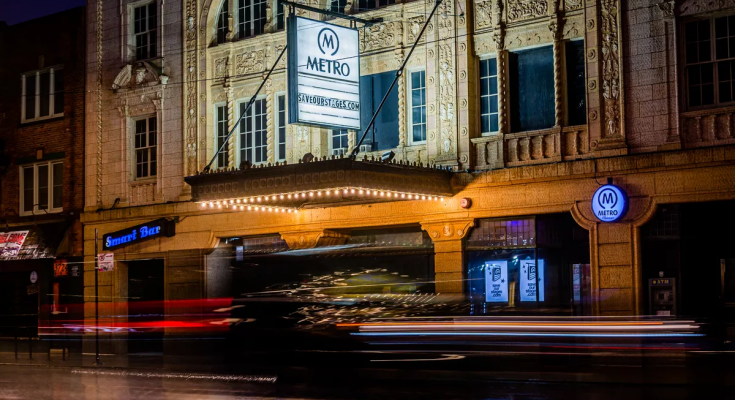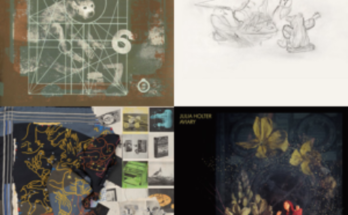
Credit: Chicago Sun-Times
Nothing will ever match that feeling when I stepped out on stage for the first time. As I paced back and forth in the green room with my guitar slung over my shoulder, making innocuous conversation about music with another performer, the sudden adrenaline rush caused a shakiness in my legs and voice. The notion that my legs just might fail me while I would be on stage only heightened my performance anxiety. To my surprise, walking up on stage and introducing myself would end up being the hardest part of that night because when it was time to perform, it was as if something came over me. My anxiety was replaced with comfort, and I found myself singing with more conviction and presence than I ever could in the comfort of my room. It was that cold January night when I realized that performing was my new passion.
Whether or not it is immediately noticeable, the connection between music artists and live music venues has been growing exponentially stronger for decades. For the last sixty years, concerts and tours have become a lucrative practice for a musician, and many music artists see gigs as the most important aspect of musicianship. However, in the face of the COVID-19 pandemic, it seems as though these two entities could not exist farther apart. Due to new social distancing laws to ensure that the virus does not spread, concert venues have been forced to close indefinitely, and many artists who have developed a passion for performance and have worked hard to hone their craft are left in a very uncomfortable position. But, we are not the only ones suffering in the music industry. The COVID-19 pandemic has given us a new perspective of the industry through the apparent struggles of music venue employees and other professionals who assist musicians with their careers. With this, we can bridge the gap between musicians and music venues, and the public will have a deeper appreciation for music venues and their workers once the pandemic is over.
Around mid-March, just about every music venue in my hometown of Chicago had to close in some capacity due to the pandemic. From your typical concert-goer’s perspective, this simply meant that the show you paid for was either canceled or postponed to a later date. The ticket for the Beach Fossils concert I was planning to attend last May was postponed three times before Schubas Tavern, the venue hosting the gig, announced last month that they would have to shut their doors indefinitely. In that same month, another independent music venue, Metro Chicago, had a staff drop from 125 employees to eight (Rivers). We can say with certainty that both artists and music venues are not bringing in enough income to survive. These developments beg the question of how much longer musicians and music venues can financially withstand the challenges brought on by the pandemic. We now realize through the COVID-19 pandemic that music as an art form has grown into a multi-faceted, complex industry with erupting problems that must be tackled in an equally complex way. Researchers at the University of Jyväskylä define the music industry as “musicians (artists) who compose and perform music, companies and professionals who create and sell recorded music, organizations involved with and giving music performances, and professionals who assist musicians with their music careers” (Naveed, Watanabe, & Neittaanmäki). It is clear that the industry encompasses an array of perspectives that suffer similar, yet separate hardships. In order to begin to consider potential resolutions, we must develop an understanding of each entity that defines the music industry.
When we first think of the music industry, our minds go straight to the artists that headline music festivals and populate our Spotify playlists Instagram feeds. Music artists make a living through multiple revenue streams, but two of the most important revenue streams are streaming sales and touring. As previously stated, the live concert has been a musician’s most lucrative space for generations. According to Billboard’s list of highest-paid musicians, U2 made $54.4 million in 2017. Of that $54.4 million, $52 million came from their Joshua Tree Tour, meaning 96% of their revenue was from touring alone. One could argue that this is partly due to U2 being a relatively older band with declining streaming sales, but even current pop stars make most of their income from touring. That same year, Ed Sheeran made $31.3 million, and 64% of that revenue came from touring (Christman). In the early 2000s, touring sales combatted lost revenue from illegal album downloads, and today, they combat the low payouts of major streaming platforms to artists. Touring also opens doors to other revenue streams. Concerts have become a primary place to sell merchandise like t-shirts and physical albums, and playing live shows has also historically been an invaluable promotional tool for music artists to gain exposure and build a fanbase on the local and global level. Ben Sisario and his co-writers at the New York Times describe live venues as “economic and creative network[s]” for musicians young and old to “hone their craft” (Sisario and Russonello). Since all these venues have closed, many artists have experienced significant creative frustration, anxiety, and depression from financial loss and job uncertainty. According to a survey conducted by Americans for the Arts, 62 percent of artists have become fully unemployed (Cohen). Another survey conducted by Musicians Union showed that 34% of the 2,000 musicians who participated “are considering abandoning the industry completely” (Beaumont-Thomas). Considering that more than half of the musicians and artists that make up the industry are jobless, you could see where much of artists’ anxieties stem from. However, music artists are not the only workers in the industry who are being affected.
Due to the nature of live music, with large crowds and close physical contact, it was with extreme certainty that millions of concert venues around the world would be forced to close indefinitely. A key point that must be stressed in order to understand the struggles of independent music venues is that they are unable to even reopen at partial or reduced capacity. Evanston entered Phase 4 on June 26, which allowed for popular music venue Evanston SPACE to open with a capacity of fewer than 50 people or less than 50 percent of maximum capacity. However, according to social psychologist Kyle J. Messick, most fees associated with concerts are fixed; therefore it is not economically feasible for music venues to adopt this practice. The “new normal” for intimate concert venues like SPACE would be attendees having to wear masks and social distance at live events, making the prospect of attending a live show less desirable–not to mention the public’s increased anxieties surrounding the spread of the virus and sanitation. Moreover, it might be impossible for fans to see their favorite artist perform since many touring artists have canceled or postponed their tours indefinitely, leaving venues searching for emerging local acts to bring in the fans.
There is also much discussion regarding post-pandemic music consumer behavior, especially how willing consumers are to attend large gatherings. A poll from Nielsen 5 Music and MRC Data found that 21% of respondents would not start going back to concerts for at least five months after the pandemic ends. A 2% minority said that they would never go to a concert again (Levy). This statistic hints that the public will remain apprehensive about entering music venues and participating in large gatherings well after the pandemic has ended. Overall, opening at partial capacity is not an option for music venues at this point, and experts say that performance venues will be the last to reopen after the quarantine is lifted and vaccines are distributed to the public. In his article on the impact of coronavirus on the music industry, Kyle J Messick projects that music venues “are to reopen sometime in 2021 at the earliest, but this would result in a loss of nine billion dollars in ticket sales alone” (Messick). According to a survey conducted by the National Independent Venue Association, “about 90% percent of independent venue owners say that they will have to close permanently within the next few months (Tsioulcas). The closing of America’s independent music venues has had a profound effect on the industry and creative ecosystem. Nicholas Rivero, co-founder and CTO of Atlanta-based production and design studio MEPTIK, identifies six occupations associated with live music that have been affected by COVID-19:
‘1) the arenas and stadiums who employ office staff, security, technical, and many more…all the way through to concessions, 2) the trucking, shipping, and logistics required to move equipment around daily, 3) the travel and lodging industries, which are deeply intertwined with live events. Crews of people are driven around on tour buses, fly major airlines daily and stay in hotels each night in-between, 4) the production vendors who supply all of the equipment to make these events happen, 5) the artists, speakers, hosts, and all of the on-stage talent, as well as the promoters, event organizers, and their logistics teams, and 6) those that design the shows themselves — individuals, studios, agencies and more (Rivero).
As you can see, a major aspect of the music industry is an intertwinement of multiple industries made up of individuals who have built their careers around the production and promotion of live concerts. With concert venues closed indefinitely and the prohibition of large gatherings, many of these individuals are left with zero income. These occupations are essential to the prosperity of the music industry as a whole. When the Beach Fossils concert I was planning to go to was canceled, the band who was to perform was not the only entity affected. Music venues use ticket sales to invest in other aspects of a concert, such as accommodations and payments for bands, payment of its employees, expenses towards putting on a concert, and promotion of the concert (Messick). These financial losses stem at the music venue and propagate through to the employees and promoters. The employees who found passion in these behind-the-scenes operations are completely out of work, and many have been laid off.
The reality of the situation is that COVID-19 has had an immense impact on the music ecosystem of industries. The immediate answer to this problem has been communication and unification of the workforce that makes up this ecosystem. There have been many instances of artists and music venues joining forces to keep each other financially stable and facilitate creative freedom. As cited in Shelley Brunt’s article on the mental health crisis in the industry, “artists used established platforms like Twitch and Patreon alongside emerging technologies, such as StageIt and Veeps, to create new revenue streams during the pandemic” (Brunt and Nelligan). However, over time, artists have begun to work alongside music venues and festival curators to release live content. For example, Florida-based record label, Speed Demon Records, teamed up with local live venue High Dive in September to record livestream performances of the artists under the label. The venue was completely empty apart from the musicians on stage and the crew, but fans were able to buy tickets to view their favorite artists perform, albeit from their living rooms. In Chicago, Uncommon Ground, known for facilitating the bustling indie music scene in the downtown area, also began livestreaming artists’ concerts hosted at their two locations. Professionally produced livestream concerts utilizing the correspondence between artist and venue has given artists an outlet to perform on stage, a way to maintain their connection with fans, and another avenue of monetization through social media. The livestream concert business model has been proven to be lucrative for artists; K-Pop boy band BTS has made no less than 44 million USD with one million tickets sold, and Glass Animals have sold over 10,000 tickets for their “Live In The Internet” performance, calling their livestream their, “biggest headline show ever” (Deborah). Filming these concerts have also provided work and money for the camera crew, on-stage crew, and mixing engineers. Livestream concerts have become a lucrative strategy that shortens the gaps between music artists, venues, and consumers.
Popular music artists have also been working with live venues to raise money to keep doors open. In August, Alex Turner of the Arctic Monkeys raffled his signature Fender Stratocaster to the public to raise money for The Leadmill in Sheffield, a venue where the Arctic Monkeys and many other world famous bands played in their younger years. This operation was in conjunction with Music Venue Trust, who have facilitated fundraisers and livestream concerts to keep venues across the U.K afloat while providing work for independent venues, production staff and film crews that have been hit hard during the pandemic (The North Will Rise Again – The Charlatans + IST IST + LIINES). The American equivalent is the National Independent Venue Association’s #SaveOurStages which has also been conducting raffles and providing livestream content. By these organizations building affiliations with thousands of struggling independent music venues, they are giving the behind-the-scenes concert production specialists, event promoters, and venue owners a more prominent voice than they ever had before.
As we arrive at the end of 2020, so much has developed in regards to the pandemic. News that the FDA has issued emergency use authorization for the first COVID-19 vaccine is great news for the music ecosystem, and we will hope to see a natural improvement in our situation (Commissioner). As of writing this article however, we are still very much in the thick of it, and the best we can do is to identify the individuals that exist and are affected in our field. At a fundamental level, whether you are a touring musician, a cameraman filming a live set, an audio engineer, or a touring roadie, your goal is to provide an immaculate experience to the world through art. It might not always be an easy or stable life, but it is one that is beyond fulfilling for the people who are passionate about living it. Through a combination of the intense research I conducted to construct this paper and my own immersion in the music scene in my hometown, I have gained a stronger appreciation for the independent venues that breed beautifully intimate performances. I now realize that it is within these venues where the music scene exists. It is where the lighting design student works on his first professional live show. It’s where the aspiring audio engineer live mixes his first performances. It’s where a young eighteen-year-old tries his hand at performing his first original song in front of an audience. The prospect of playing again gives me nothing but excitement. Will I have the same anxieties I felt during my first ever gig? Probably not; but as I enter the stage to play my first gig since a global pandemic, I will feel proud of myself that I contributed to the global discussion that got me back to the platform I feel the most comfortable in.
Works Cited:
Brunt, Shelley, and Kat Nelligan. “The Australian Music Industry’s Mental Health Crisis: Media Narratives during the Coronavirus Pandemic.” Media International Australia, SAGE Publications, 25 Aug. 2020, www.ncbi.nlm.nih.gov/pmc/articles/PMC7451503/.
Commissioner, Office of the. “FDA Takes Key Action in Fight Against COVID-19 By Issuing Emergency Use Authorization for First COVID-19 Vaccine.” U.S. Food and Drug Administration, FDA, www.fda.gov/news-events/press-announcements/fda-takes-key-action-fight-against-covid-19-issuing-emergency-use-authorization-first-covid-19.
Deborah, et al. “Paid Concert Livestreams – Are They Worth It?” Indie Is Not a Genre, 10 Nov. 2020, www.indieisnotagenre.com/paid-concert-livestreams-are-they-worth-it/.
Levy, Piet. “’We’re Talking about Life or Death’: Milwaukee Music Venues Look to Allies, and Washington, to Survive the Pandemic.” Milwaukee Journal Sentinel, Milwaukee Journal Sentinel, 28 May 2020, www.jsonline.com/story/entertainment/music/2020/04/30/milwaukee-music-venues-look-washington-survive-life-death/3036175001/.
Messick, Kyle J. “Music Industry in Crisis: The Impact of a Novel Coronavirus on Touring Metal Bands, Promoters, and Venues.” Association Européenne Des Conservatoires, Académies De Musique Et Musikhochschulen, 15 June 2020, www.aec-music.eu/userfiles/File/customfiles/messick2020musicindustryincrisis-1_20201002111902.pdf.
“The North Will Rise Again – The Charlatans + IST IST + LIINES.” Universe, www.universe.com/events/the-north-will-rise-again-the-charlatans-ist-ist-liines-tickets-baton-rouge-G91C3X?ref=ents24.
Rivers, Lydia. “Chicago’s Independent Venues Are Running out of Time to Reopen.” The Daily Northwestern, 9 Oct. 2020, dailynorthwestern.com/2020/10/08/city/chicagos-independent-venues-are-running-out-of-time-to-reopen/.
Tsioulcas, Anastasia. “America’s Independent Music Venues Could Close Soon Due To Coronavirus.” NPR, NPR, 9 June 2020, www.npr.org/sections/coronavirus-live-updates/2020/06/09/873196748/americas-independent-music-venues-could-close-soon-due-to-coronavirus.
“Win Alex Turner’s Fender Guitar.” Crowdfunder UK, www.crowdfunder.co.uk/arctic-monkeys-leadmill.




